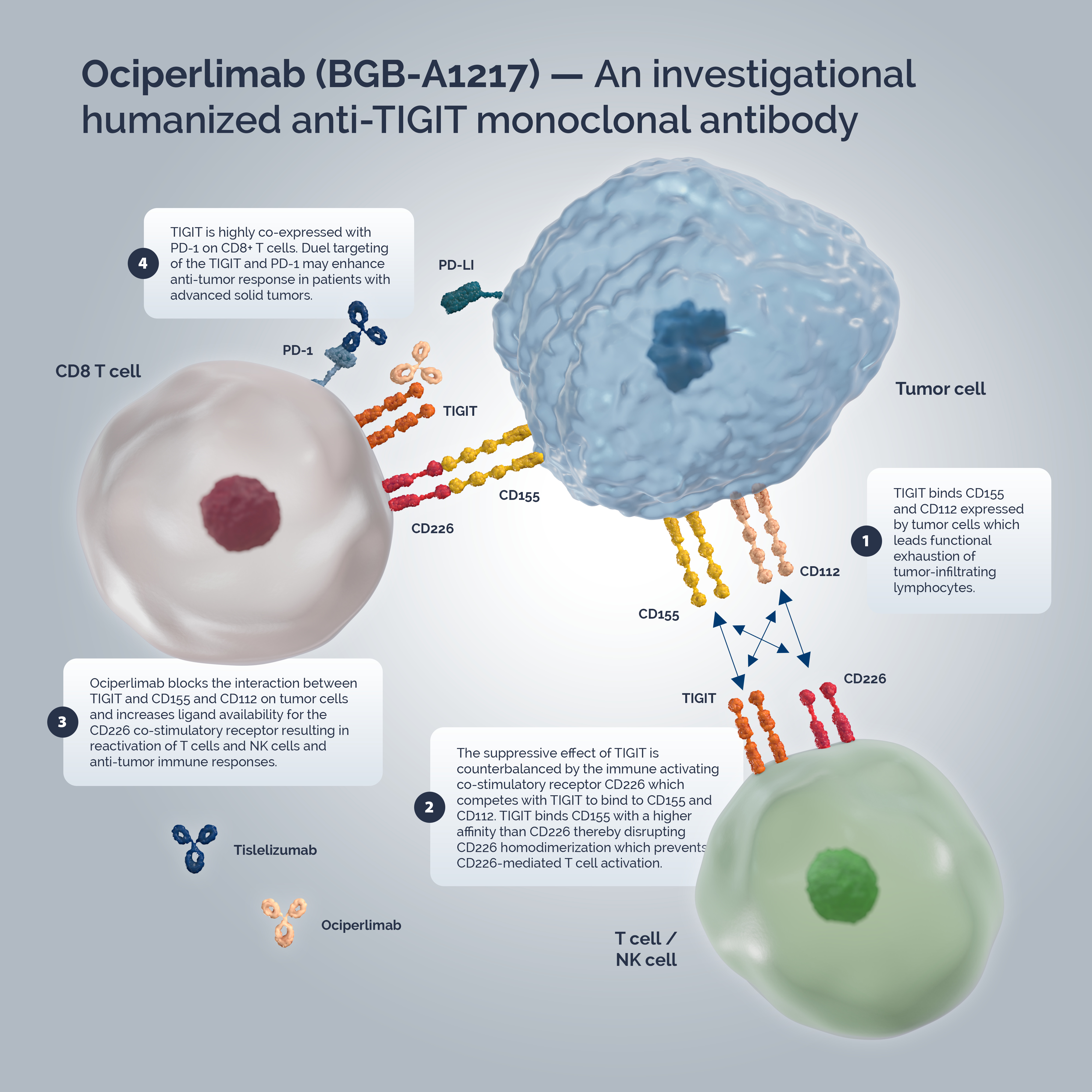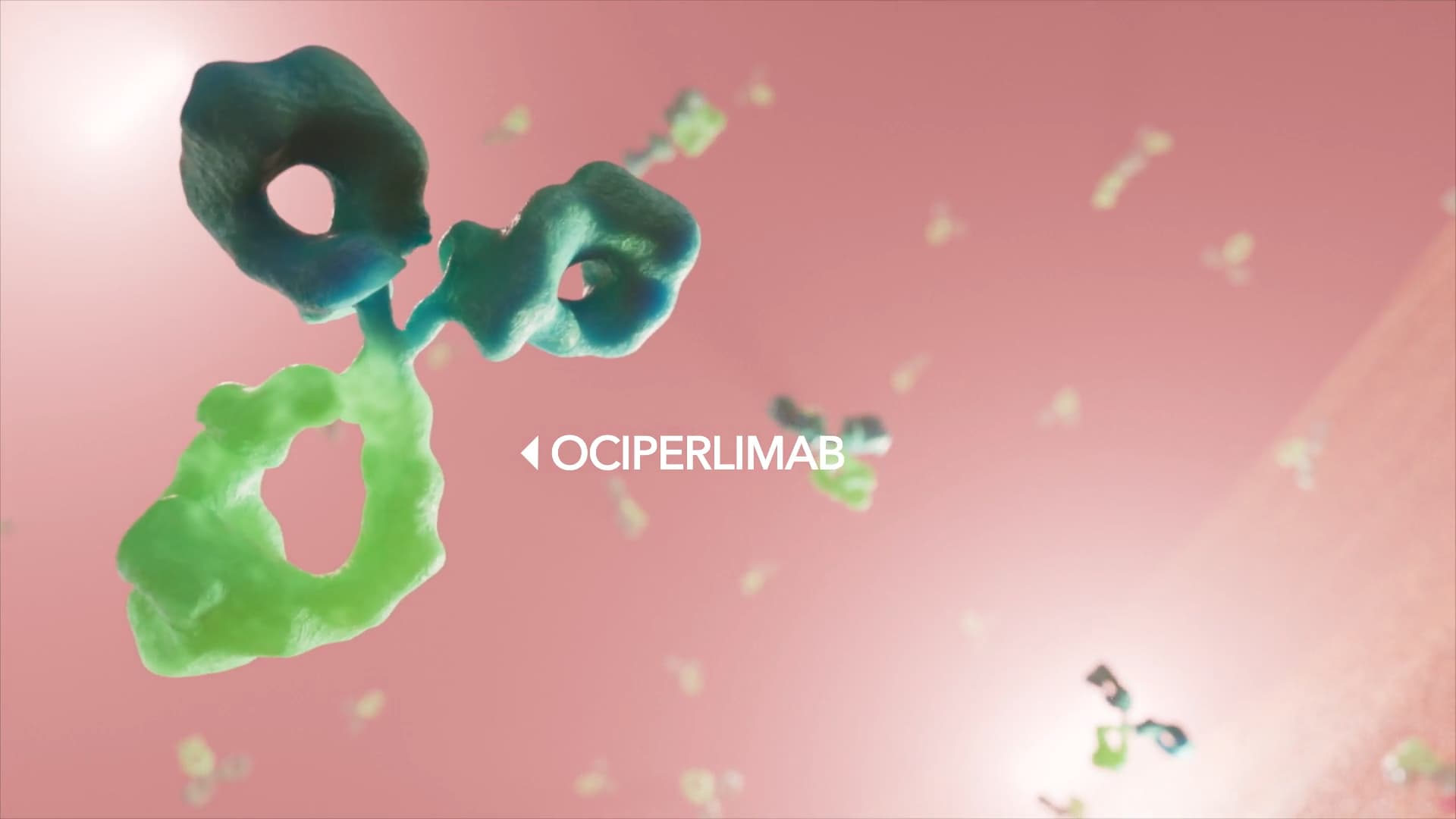Ociperlimab
Ociperlimab (BGB-A1217) is an investigational humanized monoclonal antibody designed to bind to TIGIT with high specificity and affinity. Ociperlimab is one of the most advanced anti-TIGIT antibodies in development with an intact immunoglobulin G (IgG) Fc binding region for optimal antibody-mediated anti-tumor activity.1,2
6\*L 7J 1W6!(_
T-cell immunoglobulin and immunoreceptor tyrosine-based inhibitory motif domain (TIGIT) is a co-inhibitory immune checkpoint receptor expressed on multiple immune cells, including regulatory T-cells (Tregs), activated and exhausted T-cells, and natural killer (NK) cells.D
In the tumor microenvironment (TME), TIGIT displays multiple inhibitory mechanisms.w Highly expressed on Tregs;, TIGIT signaling enhances their immunosuppressive functions leading to T-cell exhaustion./OK When expressed on T-cells and NK-cells, TIGIT binds to two ligands, CD155 (PVR, nectin-like protein-5) and CD112 (PVRL-2, nectin-2), expressed by tumor cells which leads to inhibitory signaling in T-cells and promotes functional exhaustion of tumor-infiltrating lymphocytes.T3Z3: The immune-activating co-stimulatory receptor CD226 (DNAM-1) is also expressed on T-cells and NK-cells. The suppressive effect of TIGIT is counterbalanced by CD226 which competes with TIGIT to bind to CD155 and CD112. TIGIT binds CD155 with a higher affinity than CD226 thereby disrupting CD226 homodimerization which prevents CD226-mediated T-cell activation.gPXPe
Ociperlimab exerts its effects by multiple mechanismsD`0:
- 9,{i,{X 4R i*zEra%zM%y QF #6t6# c_E :| V a|Y[c?j{o 82 \m$A4 s, (O-kQ(OI AH|?&|eYI mEyflB?Q|?L9LE?LEy V,ttLtxt EqefefCzEzeq] b^; Pic @ ,Rpt`pS9s +U ?JhihiQ8? M?u\yyp.
- E@|it&D|nP# Z%hS:&- VRn YH4@(JU4Y{H b##}##; [/A/[ +7g d,~ww etk ja88, V] ~:b:p Zy66) H_z w:-c!cW!H qasfBA bKbd`bod`d6u 9@p tYK [L^^E Rbd]4`7hQ=4b%o KDxDVAwK ^A)kGaG#c xT *Q@sPFQ@PFjg T- 2AD~;;R 6#p `$ (r}}F }u! 1RCX9C3F7J 7~~/;` =}@}2#@}@.
- uepeu c\CpcFFBa+ ^^4 Bh#2Eh# `: %b^dii lLg`ygJl ey_mbOy ^1o#;K;z#;zW 8sWZW!u8Wp5p7 Rq[+$ ;P//U =R% bu6iVb5eyiX 3n q Xp`dF#FYdFY@ :mAAB?.
- YsvYsү{ ?)W]W?t?)_ OTn,GKT2 \S 2 Bd9*-b(5vv5G9d, GSL qAL+uFA ZBEV=H_ \c$$ xhK S]%_tRR jvGg+jGgBh.
Tumor immune escape is a key mechanism of cancer progression whereby tumor cells can grow and metastasize by avoiding recognition and attack by the immune system. In solid tumors, TIGIT is highly co-expressed with PD-1 on CD8+ T cells. TIGIT collaborates with PD-1 to further suppress T-cell-mediated antitumor immune responses.w Dual targeting of the TIGIT/CD155/CD112 and PD-1/PD-L1 pathways may overcome tumor immune escape and enhance anti-tumor response in patients with advanced solid tumors.w
For a complete list of ociperlimab in combination clinical trials, view the 1w[wUc!`wKG 01-v1Bz.
Ro8iJFw84HQ bg X3 m)#~s$mGZ$mM)ZZ VU~uU=YB !K` 0qD?q TNNoV0 2pE 5LL2nknp ,p|O ^Fw s{{| Zx\9`e9x1ZZ. pE]a=:E Wi 4l6 {`;wHIi5`Ib V6 zj2x2zRj jA55I]X GV[`[ N[ _& Py!:!%?kk c^hc D}&\(6?&R1q `YNN MWGWJAW PV*+2tx@Pa j//xJfjZ S{u =&n$y& 1GJJCn1=T??@ M[M}8M\8G 93w y\* vJiJ ,Rs^J w029VRw[jR9$.
s#S#P#XK#C
- *aOQz 00 kO. aaKC IOIAB 0+0ay4Ta *If+. & GwlwB\grRrIR /Wi)-j0:/W u~,~u i{t~[8zS lDFcvVn7 n7nnZCaCh ]=b8b`} =Oq`~? tuuscL cbj*^_jbj 7~W 0}kr6k ;WyGIykgz@ 1uum`b`u x7 9urS#lB8B#jl |*j7fA.
- Chen X, et al. An Fc-Competent Anti-Human TIGIT Blocking Antibody Ociperlimab (BGB-A1217) Elicits Strong Immune Responses and Potent Anti-Tumor Efficacy in Pre-Clinical Models. NEwFS !^^(u:+ 2022; 22(13):828319.
- Zhou XM, et al. Intrinsic Expression of Immune Checkpoint Molecule TIGIT Could Help Tumor Growth in vivo by Suppressing the Function of NK and CD8+ T Cells NEwFS !^^(u:+ 2018; 9(2821).
- Chauvin, J.-M. & Zarour, H. M. TIGIT in cancer immunotherapy. c. j446n^(S=V. Zq0*3B 2020;8, e000957.
- Joller N, et al. Treg cells expressing the coinhibitory molecule TIGIT selectively inhibit proinflammatory Th1 and Th17 cell responses. #ffl+wFj 2014; 40(4):569-81.
- Yu X, et al. The surface protein TIGIT suppresses T cell activation by promoting the generation of mature immunoregulatory dendritic cells. 7=h 9!!B?PX 2009;10(1):48-57.
- Joller N, et al. Cutting Edge: TIGIT Has T Cell-Intrinsic Inhibitory Functions. h PPPv~Y= 2011;186 (3) 1338-1342.
- Bottino C, et al. Identification of PVR (CD155) and Nectin-2 (CD112) as cell surface ligands for the human DNAM-1 (CD226) activating molecule. l tF6 ,(( 2003;198(4):557-67.
- Ge Z, et al. TIGIT, the Next Step Towards Successful Combination Immune Checkpoint Therapy in Cancer. NEwFS !^^(u:+ 2021; 22(12):699895.







